Small corner cabinets in the hallway: types, design and selection
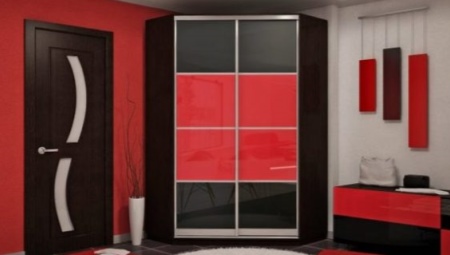
Making out a small hallway, it makes sense to think about a small corner cabinet. As you know, corner structures save free space, and they look very stylish.
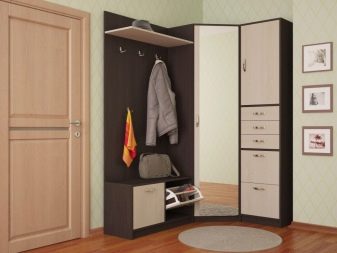
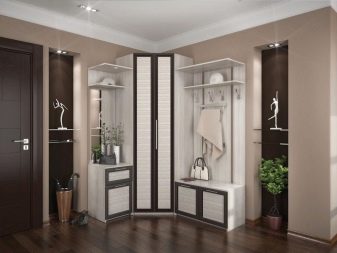
Advantages and disadvantages
A small corner wardrobe in the hallway has a lot of advantages. First of all, we are talking, of course, about an attractive appearance. Even when the corner cabinet is not part of the set, it looks very interesting due to its unusual shape. Together with other items of the modular group, this design makes a harmonious combination. The wardrobe takes up little space and is quite compact, despite the hinged door design.
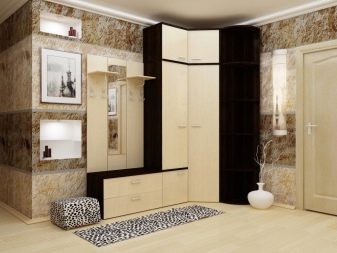
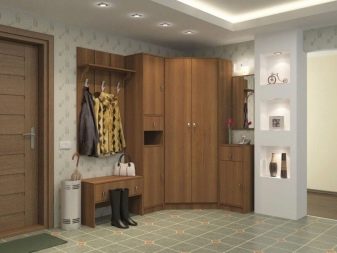
This module is very spacious, which is especially important for the hallway, where seasonal items, hats, gloves, and bags often require storage. In addition, L-shaped structures allow you to visually correct the poor shape of the hallway or visually expand the space. Nevertheless, it is still customary to highlight several disadvantages in such cabinets. Tall structures create certain problems with getting and folding things on the top shelf. The best solution would be to place seasonal clothes there that do not require regular use.
The opening system still "steals" the free passage. Of course, you can order a compartment format design, but given the small size of the cabinet, there is no particular sense in this.
A relative disadvantage can be called the requirements for the selected material, since the entrance hall is a walk-through area, and so that the furniture does not quickly fail, it must be reliable.
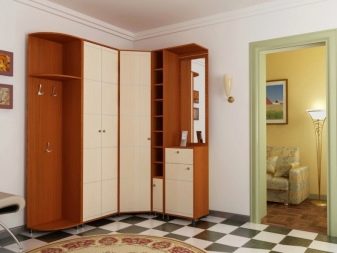
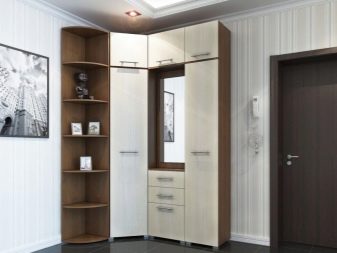
Types of structures
Available small corner cabinets are usually subdivided into three main groups: case, modular and built-in.
Body element sold ready-made or assembled to order according to individual parameters. Although the cabinet is small, it is a complete structure with side panels and top and bottom panels. Often, the wardrobe is delivered to the apartment in a collapsible form, and then the master or the owner himself brings it to the required state. The cabinet cabinet is relatively easy to rearrange from place to place, as well as transport when moving.
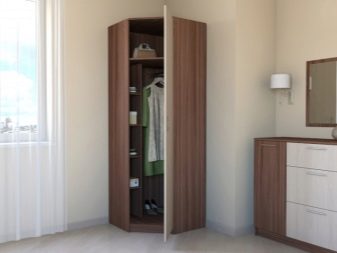

Built-in a corner cabinet is placed in a niche or recess of a suitable size. It not only creates the maximum possible storage space, but also corrects the unfortunate architecture of the room. Since there is no need for the production of walls, only doors and storage systems have to be ordered, thereby significantly saving on ordering. Such a cabinet cannot be simply rearranged, it will have to be completely dismantled, and therefore the choice of location must be deliberate.
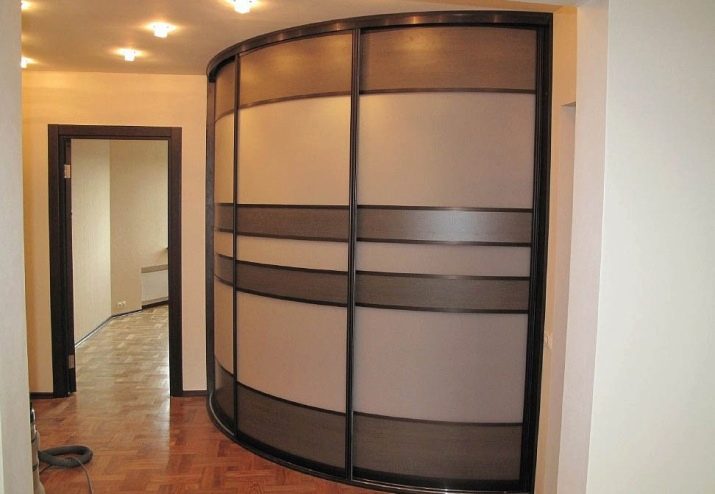
Modular wardrobe assembled from several floor and suspension modules, which are selected taking into account the things required for placement. It is quite easy to modify or add the necessary detail.
It fits well in a small space.
Depending on the type of doors, the wardrobe can be classic with opening panels, or the same type of compartment.
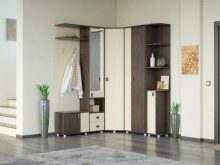
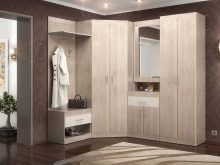

Manufacturing materials
Corner wardrobe in the hallway can be made of different materials, but it is important not to forget about the importance of their strength. When using MDF, the panels must be additionally covered with veneer from various types of wood. Such a coating turns out to be environmentally friendly, and the appearance is quite stylish.


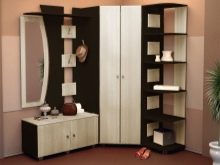
The chipboard used for the manufacture of the cabinet is additionally covered with gloss, which is responsible for increasing the strength. It is quite easy to take care of such furniture, and the appearance fits into any interior.
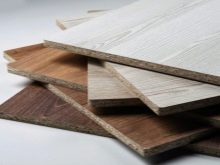

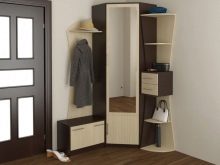
Of course, corner structures made of natural wood look the most spectacular. Most often, such models are chosen for classic interiors and are additionally decorated with carvings and decorative elements.
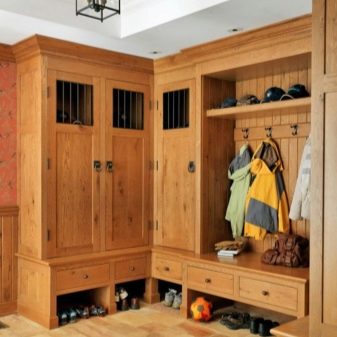

In principle, in modern interiors, corner cabinets made of plastic or drywall are sometimes found. Such furniture looks quite unusual, and it is extremely easy to care for it. In most cases, the base of the cabinet is still made of wood-based panels, and then covered with plastic.
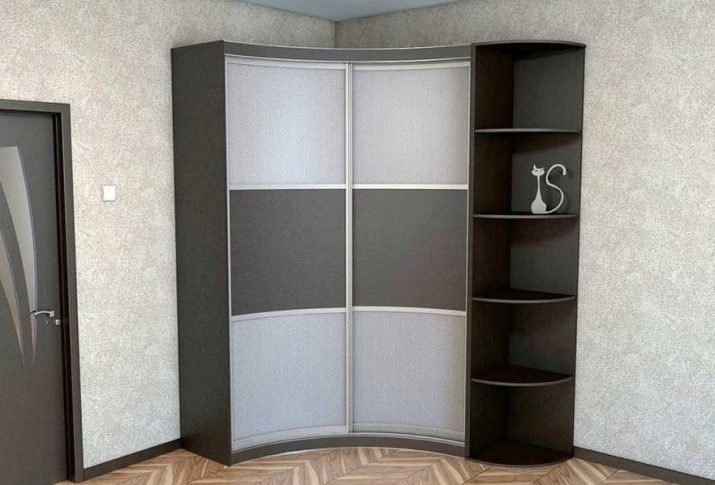
It is customary to make doors of the corner structure from the same material as the cabinet itself, but additionally decorate with the use of a different material.
For example, it can be a mirror surface, self-adhesive film, colored cladding or painting. Quite often, the doors are decorated with photographic printing.
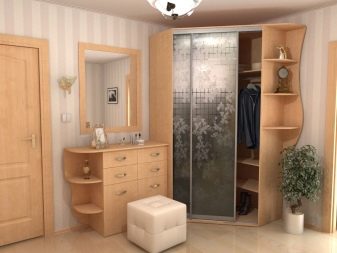
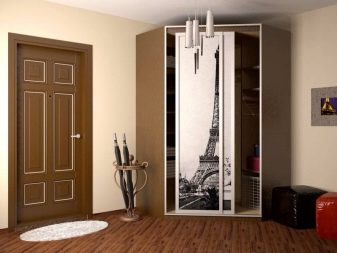
Shapes and sizes
Small corner cabinets in the hallway can be made in several basic forms. The triangular design is the most common. It allows you to use the entire space of the corner, placing a large number of things inside. However, the use of triangle-shaped shelves is not the most convenient.
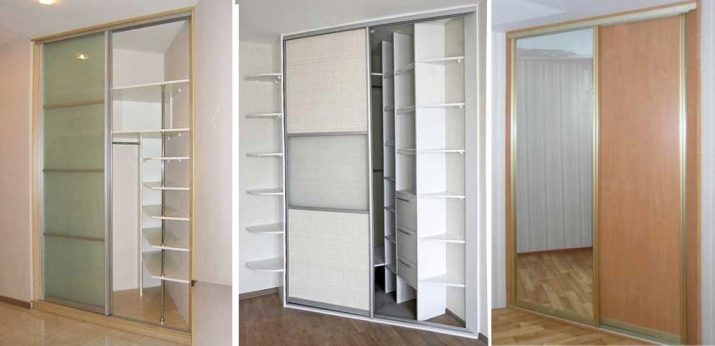
The L-shaped cabinet is located along two walls, forming a right angle. It is customary to place such a model in elongated and narrow spaces and additionally cover the doors with mirrors.
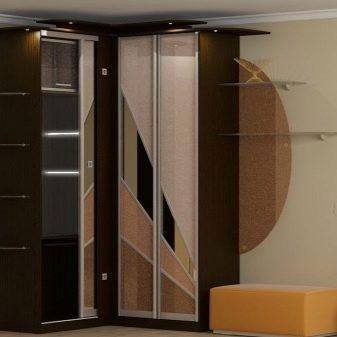
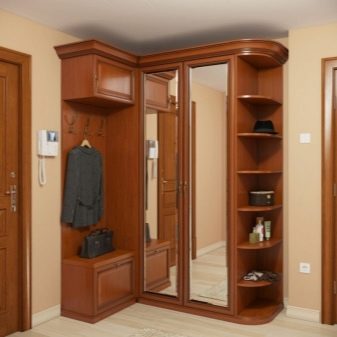
A radial wardrobe is formed by using curved doors, which either slide open like a compartment, or simply open outward. Such corners provide comfortable movement throughout the room and do not take up square meters.
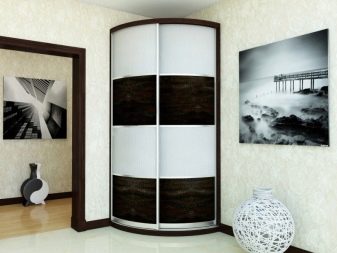
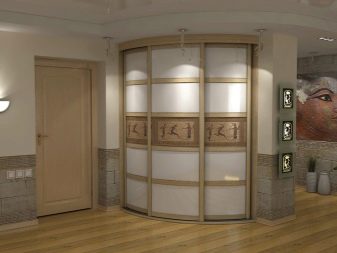
The trapezoidal cabinet has a huge area, which is formed by several compartments with shelves: one central and a pair of side ones.
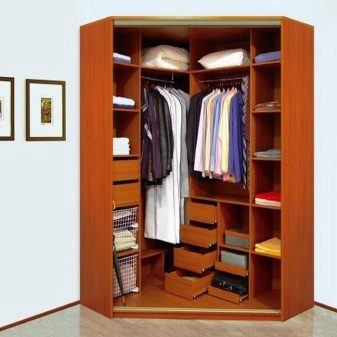
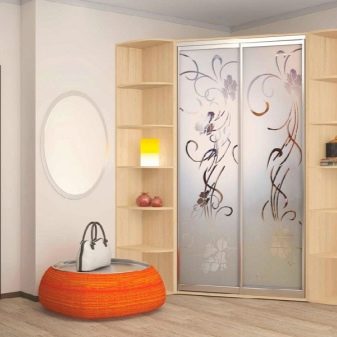
It is most correct to determine the sizes depending on the specific situation, since the hallways in different apartments have different areas and shapes.
Nevertheless, there are a number of indicators that guarantee the usability of the design. The height of a small cabinet should be at least one and a half meters, and the depth of each side should be at least 30 centimeters. It is more correct to determine the width depending on how much available space is available in the room. The maximum comfortable corner depth is 600x600 mm.
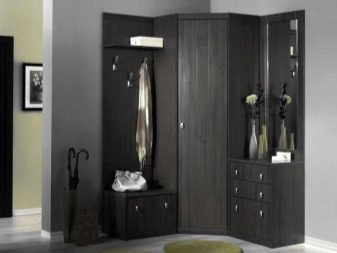
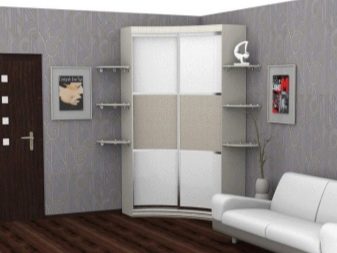
Appearance
It is customary to determine the design of the appearance of a corner cabinet in the corridor depending on the existing style. Furniture made of natural wood looks best in a classic interior.
If space permits, then you can order a structure in a dark shade, but in small hallways, it is recommended to give preference to light colors.
Regular geometric shapes, as well as volumetric decorative elements or carvings are encouraged. In more modern versions, of course, it is logical to refuse deliberate luxury.
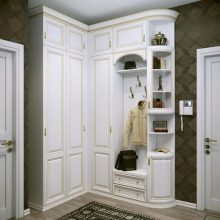
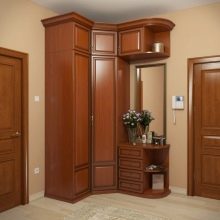
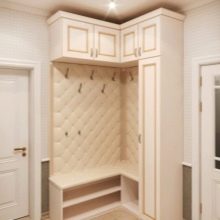
The Provence-style hallway will ideally house an artificially aged wooden cabinet. It's good if it turns out to be decorated with a pattern or carving, but not flashy and in pastel shades. Light wood looks good in rustic interiors, although MDF will also serve as a good alternative.
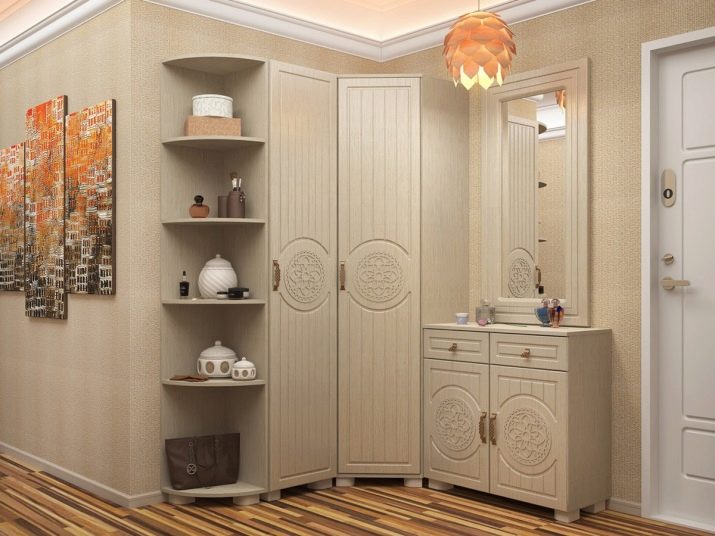
The minimalism style, as a rule, requires a monochromatic laconic cabinet, painted in white or gray, or simply covered with mirrored panels. In this case, decorative elements should be absent.
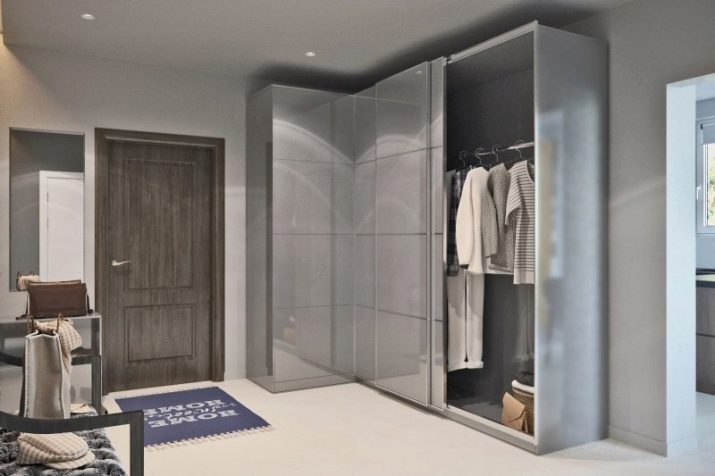
Art Nouveau allows you to experiment with colors and shapes. An L-shaped modular wardrobe or a radius structure will successfully fit into the hallway. Colors are selected depending on the rest of the interior.
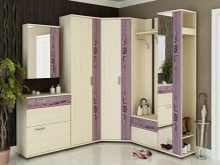
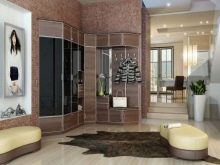
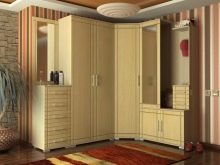
For a loft style, a massive wooden cabinet is suitable, which goes well with a traditional brick wall. Doors can be used both swing and compartment type.
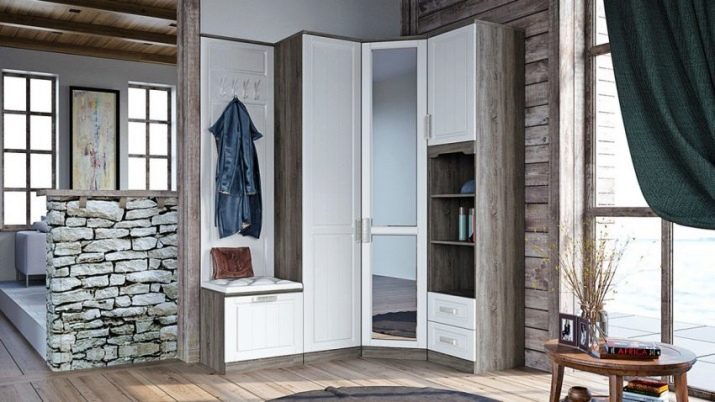
How to choose?
You should go to the store for a corner cabinet only with printed dimensions and room configuration. This will allow you to make the best choice regarding the length, width and depth of the purchased structure. In addition, it is important to understand what kind of items will be stored inside, as well as in what quantities.
It is important that the chosen wardrobe matches the color scheme of the hallway interior, as well as its basic style.
For a small space, it is better to choose cabinets with mirrored doors to visually increase the space. Before buying, experts advise to make sure of the reliability of the fittings, the strength of the material, as well as internal storage systems.


Successful examples in the interior
Numerous ideas for choosing a corner cabinet for the hallway allow you to choose a design that is suitable for any interior. If there is very little space in the hallway, then the corner cabinet becomes a real salvation.
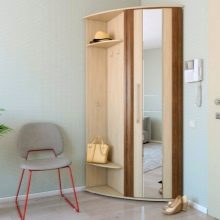
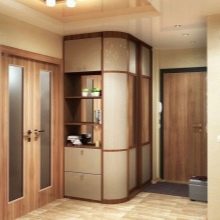
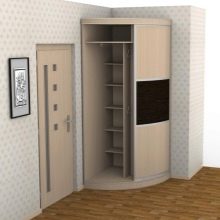
A fairly compact version, made of brown wood panels, almost completely occupied the existing corner. Hinged cabinet doors are covered with mirrored panels, and additional lighting is mounted on top. In the small free space left between the left wall and the door itself, shelves are mounted, allowing you to arrange decorative elements, as well as store those items that should be at hand when leaving the house. This model of a corner cabinet is quite classic, and therefore will fit into most hallways.
In another example, the wardrobe also occupies the entire corner at the front door, but since there was more space, and the model was chosen more complex. There is additional lighting inside, and compartment-type doors do not interfere with the passage.The furniture is made of light-colored wood panels and decorated with self-adhesive in contrasting shades of black and white. One of the walls of the cabinet is equipped on the outside with shelves and hooks for outerwear. It should be added that the color scheme of the wardrobe echoes the nightstand complete with a mirror, located opposite.
Light shades further expand the room and create an interesting contrast to the dark floor.
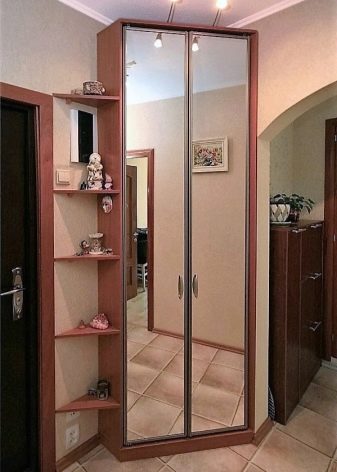
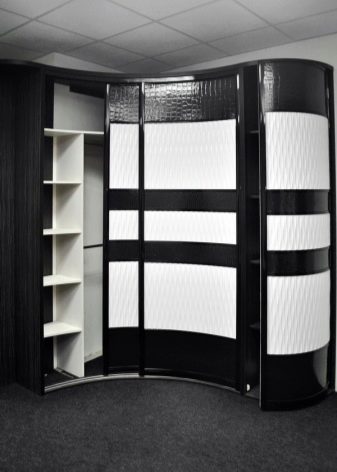
In the next video - installing a corner cabinet in the hallway.








